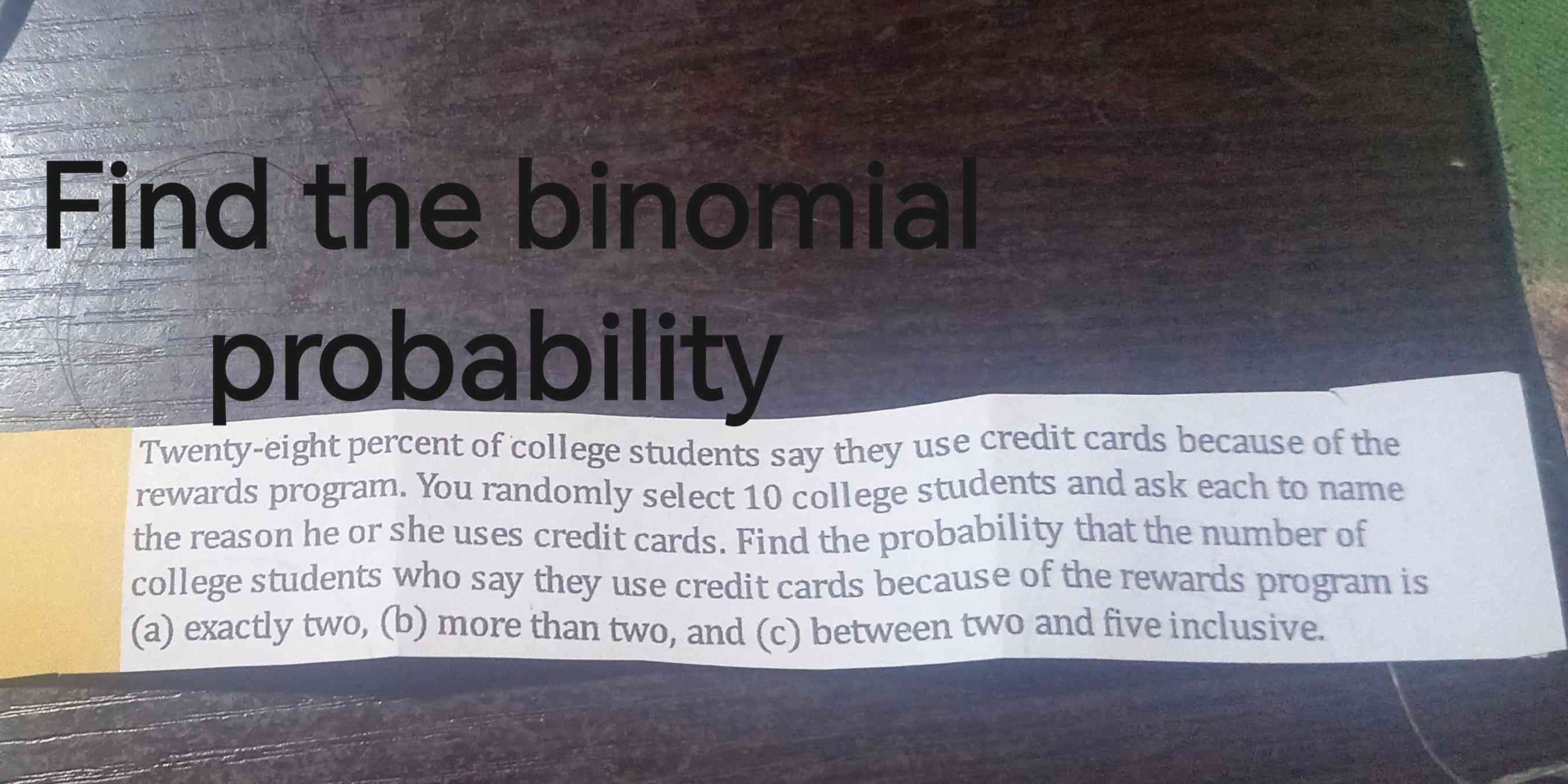Twenty-eight percent of college students say they use credit cards because of the rewards program. You randomly select 10 college students and ask each to name the reason he or she... Twenty-eight percent of college students say they use credit cards because of the rewards program. You randomly select 10 college students and ask each to name the reason he or she uses credit cards. Find the probability that the number of college students who say they use credit cards because of the rewards program is (a) exactly two, (b) more than two, and (c) between two and five inclusive.

Understand the Problem
The question is asking for the calculation of binomial probabilities based on the given scenario involving college students and their credit card usage. We need to determine the probabilities for specific counts of students who say they use credit cards due to a rewards program.
Answer
- (a) $P(X = 2) \approx 0.2222$ - (b) $P(X > 2) \approx 0.6793$ - (c) $P(2 \leq X \leq 5) \approx 0.5934$
Answer for screen readers
- (a) Probability of exactly two students: $P(X = 2) \approx 0.2222$
- (b) Probability of more than two students: $P(X > 2) \approx 0.6793$
- (c) Probability of between two and five students: $P(2 \leq X \leq 5) \approx 0.5934$
Steps to Solve
- Identify the parameters of the binomial distribution
In this scenario, we have:
- The probability of success (a student using credit cards because of the rewards program) $p = 0.28$ (28%).
- The probability of failure $q = 1 - p = 0.72$.
- The number of trials (students asked) $n = 10$.
- Define the binomial probability formula
The binomial probability formula is given by:
$$ P(X = k) = \binom{n}{k} p^k q^{n-k} $$
where:
- $P(X = k)$ is the probability of exactly $k$ successes,
- $\binom{n}{k}$ is the binomial coefficient, calculated as $\frac{n!}{k!(n-k)!}$.
- Calculate probabilities for the specific cases
- (a) Exactly two: Calculate $P(X = 2)$
Using the parameters from step 1 and plugging $k = 2$ into the formula: $$ P(X = 2) = \binom{10}{2} (0.28)^2 (0.72)^{8} $$
- (b) More than two: Calculate $P(X > 2)$
This can be calculated as: $$ P(X > 2) = 1 - P(X \leq 2) = 1 - (P(X = 0) + P(X = 1) + P(X = 2)) $$
For $P(X = 0)$ and $P(X = 1)$, repeat the same formula as in step 2.
- (c) Between two and five inclusive: Calculate $P(2 \leq X \leq 5)$
Sum the probabilities: $$ P(2 \leq X \leq 5) = P(X = 2) + P(X = 3) + P(X = 4) + P(X = 5) $$
Calculate each of these using the binomial probability formula.
- (a) Probability of exactly two students: $P(X = 2) \approx 0.2222$
- (b) Probability of more than two students: $P(X > 2) \approx 0.6793$
- (c) Probability of between two and five students: $P(2 \leq X \leq 5) \approx 0.5934$
More Information
The binomial distribution is used when there are a fixed number of independent trials, each with two possible outcomes (success or failure). A typical application is in surveys or experiments involving choices or preferences.
Tips
- Calculating probabilities incorrectly: Be sure to correctly calculate the binomial coefficients and apply the formula.
- Misunderstanding the range: When calculating probabilities for ranges (like exactly, more than, or between), carefully understand what is being asked to avoid adding incorrect probabilities.
AI-generated content may contain errors. Please verify critical information